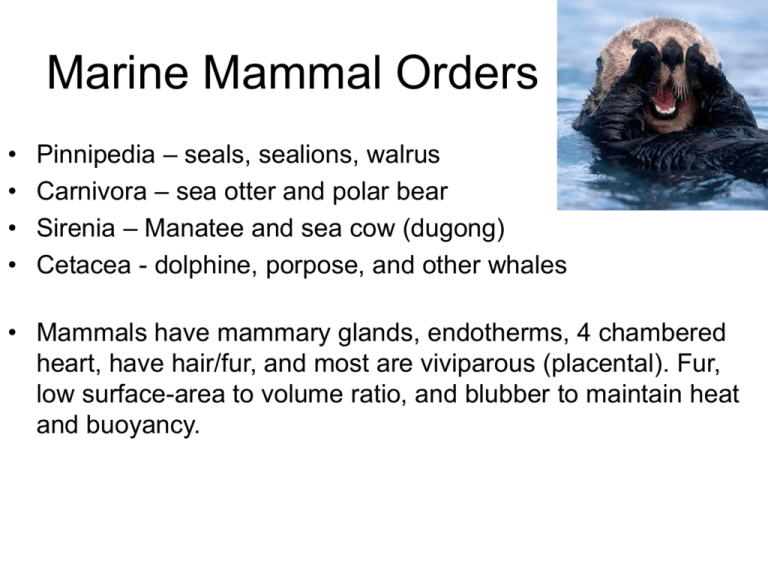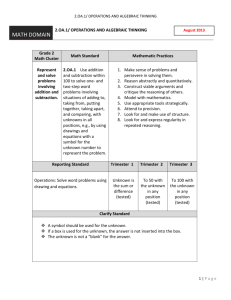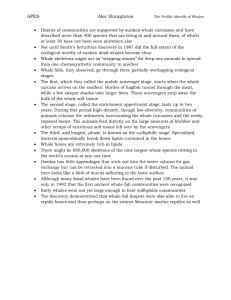Ch. 8 Other Chordates - Mater Academy Lakes High School
advertisement

Marine Mammal Orders • • • • Pinnipedia – seals, sealions, walrus Carnivora – sea otter and polar bear Sirenia – Manatee and sea cow (dugong) Cetacea - dolphine, porpose, and other whales • Mammals have mammary glands, endotherms, 4 chambered heart, have hair/fur, and most are viviparous (placental). Fur, low surface-area to volume ratio, and blubber to maintain heat and buoyancy. Carnivores • • • • Sea Otters: Life in water - even giving birth. Groom fur to trap heat. 100,000 hairs cm2 Keystone specie in kelp beds. Eat 30% their weight of urchins, shellfish, and crabs daily. 3x faster metabolism for heat. • Orcas ate over 40,000 otters in 100 years. • Polar Bear (means “arctic”): spend most of their life in water traveling from ice sheet to ice sheet, which are now scarce. • Eat seals. Ferocious hunters stomp on dens. • Arctic is the word for polar bear. Antarctica (south) is where polar bears do NOT live. • Still hibernate in dens. • Have 2 cubs per year. Sea Otters • Sea otters spend the majority of their life in the water. They even sleep and always eat in the water. • They must keep their feet out of the water to stay warm. • They use rocks as tools to open shellfish. • Sea otters must eat 25 percent of their body weight each day in order to stay alive. • Otter fur has 350,000 hairs per square inch. 1 4in. by 4 in. section is equal to 48 human heads of hair • They nearly went extinct from fur traders. Now they are legally protected, but the Orca whale just discovered how tasty they are. • Out of 16,000 otters living in the spill zone, 1000 died, 400 were treated, but only 200 were able to be returned to the wild. The oil also killed 37,000 birds. • It harmed 1000 miles of shoreline and the entire food chain. Sea Otters and Oil Spills • When a sea otter's fur was oiled, the fur can no longer hold the protective air layer that keeps them warm so they die. • Oil spill caused reproductive failure in sea otters and many juveniles died from oil in their food. Pinnipeds • Seals: paddle-foot. Rest on land, swim under water up to an hour. • Baby seals have white fur for warmth and camo. • More than one den to protect. 10 days then water. • Evolved from “cat” and “dog”. • Seals strain krill with teeth. • Sea lions have ears, external genitalia, and can move back flippers forward. • Walrus uses tusks for defense and vibrissae (feelers) to find and suck up clams. Blush to release body heat. Sirenia • Manatees There are 1000 left. • Most killed by boats or lack of sea grass. • Front flippers and no legs. Just a tail with flukes. • Humans hunted for meat, skin, and oil in blubber. • Harmless and curious. • Named after mermaid songs. • Descended from elephants. • One calf every 3 years. Males are not mature until 9. Cetaceans: Whales • • • • • Warm blooded. 4 chambered heart. Placental (live) birth. Internal mammary gland and genitalia. Can dive 2 miles deep and grow Developed echolocation through modified ear and jaw bone. Vestigial hair and pelvic bones present in embryonic stages. Why have them if you don’t use them? • Transitional stages in fossil record. • Convergent Evolution of analogous features: flippers, flukes, and streamline body (different make up, but similar function. • Homologous structures: same make up, but work very differently. Same bones as our hand, but shaped into a flipper. Convergent Evolution Analogues Structures Homologous Structures Vestigial Structures 30 meters (90 feet) Largest Animal EVER! Feeding • Baleen whales eat plankton, krill, and small schooling fish that they filter with their baleen (made of keratin). • Toothed whales may eat larger fish and mammals, such as seals. • Killer whales (orca) splash large waves on ice bergs to wash seals off into the water where the pack of whales are waiting to feed (on you-tube). Rorquals with Throat Grooves Echolocation • Sperm Whale (Moby Dick): sailors used to think the enlarged head contained sperm. • Now we know it is full of oil (ambergris) used for echolocation. • Used in place of smell Echolocation • Melon: head full of oil. • Spermatocie is the oil within the melon. • The oil is also used for buoyancy and to absorb extra nitrogen • Lower jaw bones are filled with oil to transmits sounds to the inner ear chamber. • This produces an image similar to sonar • It can also send a shock wave “Big Bang” to kill their food Arctic Beluga Whales Dorsal ridge instead of fin (dorsal fins causes heat loss and would get stuck on ice). You can watch their bulging melon can change shapes during echolocation Calves are born gray and lighten with age. Vocalization • Separate from echolocation • They communicate to each other through sounds “clicks”, “chirps”, and touching • Used to maintain distance • They recognize each other by sound • Feeding signals and alarms • They also say hi and play with bubble rings • Whales sing to attract mates Dolphin Swim Dolphins and whales may swim up to 30 mph. Dolphins jump out of the water to breathe when speeding. They do tricks for fun and are conditioned with rewards. Very playful, but can attack with rostrum. Hunt in packs. Cognitive Ability: http://library.thinkquest.org/17963/genus-Tursiops.html Hydrodynamics–Dolphins swim fast! Cetacean Breathing • The nose of this order of marine mammals has been adapted into a blow hole which is located at the top of the head. • Either one or two nostrils that can clamp shut to prevent water from entering. • They are conscience breathers so only half of their brain can shut down at a time. They laterally sleep with one eye open and half a brain a wake. Then they rotate to the other side for the next 8 hours. Blood and Oxygen Storage • Dolphins have larger lungs than humans and can hold their breath much longer. They can dive for 1 hour. • 15 to 25% air exchange in human compared to 80 to 90% air exchange in whales • They store 10 to 30 x more oxygen than us. • They have 2 x more blood per pound in whales than humans Adaptations for Diving • Diving down 2 miles (7,300 ft) for food and protection for 1 h. • Blood vessels in tongue reduces heat loss • 90% gas exchange in one breath (20% in us) • 3000 times more air than humans • More red blood cells with more hemoglobin and myoglobin (in muscles) to store oxygen • Heart rate drops to 12 instead of 85 beats/min. • Blood is directed from fins to vital organs (brain and heart) only to maintain body heat at ocean depths. Avoiding the Bends • Nitrogen dissolves into the blood under high pressure, but upon surfacing it sends deadly bubbles to the brain and joints (painful) like carbonation in a 2 liter. • Divers must go into a decompression chamber if they are lucky! • Whales’ flexible lungs collapse under the water’s pressure squeezing out all of the air so that nitrogen cannot get into the blood stream and forces oxygen into central body cavities. Blubber • 20 inches of blubber in Bay Whale • Blubber retains body heat and prevents melting ice because it keeps the heat within the body (insulates). Your body can loose heat twice as fast in water. • Blubber also helps buoyancy. • Whales stay warm by redirecting blood away from the thin flippers and keep it near the core of the body to stay warm. Behavior • Whales and dolphins will protect by attacking with rostrum. They even spy. • They will surround, support/carry, and stay with their dead and dying until they rot. • Hierarchy among pod (family) members. • Monogamous partners. If one partner dies the other may stop eating. • Dolphins are one of the only animals to find pleasure in intercourse. They have been to reported to have been aroused by humans and rape sharks. Breaching • Whale species can be identified by the size and shape of their blow spout • They breach to look for landmarks and danger • warning signal • Find fish • fun and itch Migration • Gray Whales stay in the feeding grounds for about four months moving south in late September and early October (Watson 1981). • The second habitat is the breeding grounds off Baja California. • There, Grays vacation in the 71-degree waters where they give birth and keep the calves warm for enhanced survival. Reproduction • • • • • • • • Bachelor and harem groups. Penis can exit genital slit 9 ft. A second props the couple together. Delayed Implantation of the zygote for up to 4 months until female gets to the nesting ground. 12 month gestation - calf born where conceived. Females give birth alone while guys hit on the next ladies Calves are nursed for 8 months and then migrate Calves are weaned when they reach the Arctic Raising the Young Whales at Sheds • Baby beluga whales are gray because they live in estuaries not within the white ice. This skin will slough off to white by the time it will migrate north to the ice. • At Sheds scientists were studying the biological processes of the baby whale, such as, when they go potty, breathing rate, growth, and socialization. She has gained 200 lbs. in 2.5 months. They compare these statistics with past success of captive bred whales. Dominance within the pack and submissive behaviors (such as sharing food with others) are dangerous. Dominance is displayed by jaw popping and charging. • Their dorsal fin has been modified into a ridge so they can swim closer to the surface (beneath the ice) to obtain oxygen and to break up ice sheets. • They act like canaries and can mimic sounds. At Shedds, one whale mimicked the sound of the broken washing machine. Psychology • The cerebrum makes up a large proportion of brain used for sensory interpretation, thinking, and memory. • Conditioned learning: practiced behavior is “trained” or reinforced with reward. • Recognize sounds, symbols, & sign language • Complex messages to communicate in pod, hunt in packs, and adlib responses to trainers • Discover and use tools in nature (protection) • Learn by observation-mimic other animal and human behavior with sound effects! • Perform cognitive tests. Identifying self in mirror by picking up an object. • Recognize each other by sound • They learn more from peers than parents Beaching • Unknown reason •They refuse to move •Efforts to put them back in the water usually fail because the whale re-beaches •They think it is a problem with their magnetic compass • On land their weight crushes their internal organs Whale hunting • One whale is worth $100,000. • Whale oil: Before petroleum was discovered, whale oil was the primary fuel for lamps. It could also be used to make candles. Whale may be used in cosmetics, • Whale vomit (ambergris) the size of a base ball is worth $18,000 dollars because it is used in perfumes. • Before we had plastic, the baleen was used to make corset stays, combs, house rafters, and even buggy whips. • In the old days the Eskimos used to eat and use every part of the whale. • The human being has killed 90-95% of many whale families. Others are already extinct. Harpooning over 100,000 Whales in 2005! International moratorium banned commercial whaling over 20 years ago. The Japanese are exploiting a loophole (whaling for scientific research). Greenpeace was attacked! Dolphin Safe Tuna - not so safe! • Contaminants (pesticides, metals, plastics, etc.) accumulate in the tissue of dolphins. • Injuries or deaths due to boats. • Fishing nets – especially TUNA even most “Dolphin Safe” tuna now. Dolphin Attacks in Japan • Thousands of dolphins are slaughtered annually in Japan. Females are taken for display and the males are killed for a $10,000 reward (each). The Japanese claim they are depleting their fish. • They feed the dolphin meat to their school children. It contains high levels of mercury. • Celebrities tried to stop them. They almost got thrown in jail for a VERY long time. Whales Blue whale Right whale • http://www.scienceandsociety.emory.edu/scienceinyourlife/cetacean s.htm • http://www.spawar.navy.mil/sandiego/technology/mammals/animals. html • http://www.acsonline.org/factpack/whlparts.html • http://crd.dnr.state.ga.us/content/displaycontent.asp?txtDocument=3 65 • http://www.nmfs.noaa.gov/pr/species/turtles/leatherback.htm • http://www.biologycorner.com/bio3/notes-chap16-evidence.html • http://en.wikipedia.org/wiki/Dolphin • http://bss.sfsu.edu/holzman/courses/Fall99Proje cts/greywhale.htm


![Blue and fin whale populations [MM 2.4.1] Ecologists use the](http://s3.studylib.net/store/data/008646945_1-b8cb28bdd3491236d14c964cfafa113a-300x300.png)



